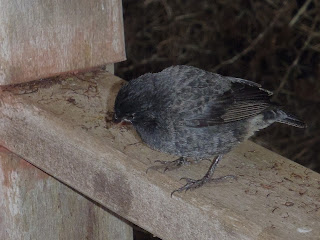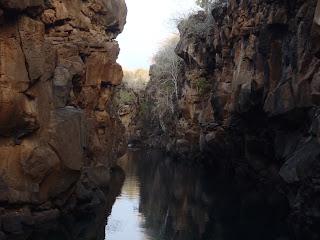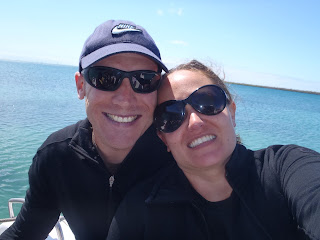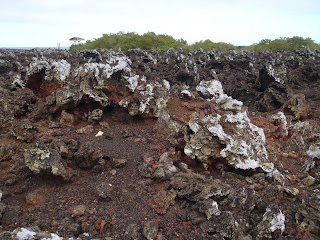Jace had been asking me for a couple of weeks where I wanted to be on my birthday and in Popayán, after reading our friend Chris’ trip log of his journey as an “independent traveller” on the Islands, I told Jace, “The Galapagos.”
When we met up with Chris in Salento, Jace and I quizzed him for more details. A lot of the information we’d read up till that point had been very low on details for independent travellers to the islands. However, from what Chris told us, the hardest part was going to be getting a flight from Quito to Baltra as most of the tickets were bought up by the various tour companies well in advance.
As it turned out, that part was actually very easy. When our flight arrived in Quito, we simply walked up to the AeroGal counter and booked tickets to leave the next morning and return the morning of our flight back to Bogotá. Our luck was probably helped by the fact that the high season was ending.
Isla Santa Cruz
Once we arrived at Baltra airport and crossed Isla Santa Cruz to Puerto Ayora, we quickly found very cheap accommodation: $20 per night for a double room with private bathroom (including hot water) – absolute bargain! – and a cheap lunch: soup, main and a drink for $3.50. I bought a bottle of water before leaving and the lady only charged me a total of $6.75 for 2 lunches and the water. Uh, ok… It was looking like the Galapagos Islands were going to be pretty inexpensive if we played our cards right.
Along the main street in Puerto Ayora which ran parallel to the harbour, fishermen sold super-fresh seafood to locals, travellers and restaurants alike.
Bet that pelican would love some fresh tuna
Fresh lobsters, anyone?
That afternoon, we walked to the Charles Darwin Research Station (free!) to take a look at the giant land tortoises. There was a fair bit of information around in both Spanish and English, and we also “overheard” some information from a tour group ahead of us. It was great to walk through the research station without being rushed around in a group and still learn a lot. We went to the baby tortoise crèche, where the tortoises are separated by year of hatching and island until their shells reach 20-30cm in diameter (3-5 years) when they are returned to their home islands.
These little ones from Isla Pinzón hatched in 2007 and their shell were about 15cm in diameter
We saw the famous giant land tortoise, Lonesome George, who is about 70 years old and is the last of his species. Researchers have been trying to mate him with 2 females from a nearby island but the poor old guy doesn’t know what to do; apparently young tortoises learn about sex from watching the adults and since old George has never seen other tortoises “do it” he hasn’t tried it himself. One female researcher took upon herself the arduous task of (ahem) manually obtaining some sperm, but after weeks (and RSI, no doubt) she gave up. Extracting some in a similar way to what is done with horses (i.e. a giant syringe) has been considered but they fear irreparably damaging George. When someone in the tour group ahead of us suggested cloning, the guide said brusquely that there had been talk of it but that would never be allowed to happen. Poor Lonesome George, looks like he’s the last of his line!
Lonesome George looks kinda sad
One of George’s females stretches her long neck to eat
A couple of females in another enclosure
It’s a hard life *yawn*
Next we saw some land iguanas just chilling in their enclosures. Unlike their maritime cousins, we didn’t get to see any of these in the wild. These vulnerable reptiles are very rare and are slowly being brought back from the edge of extinction.
An older male land iguana
During our time at the research station, and throughout our time on the Islands, we were constantly surrounded by different finches. These cute little birds were the proof of Darwin’s evolutionary pudding and with their differently adapted beaks, have diets varying from seeds to insects to blood; some even use sticks as tools to extract their fare.
A Medium Ground Finch
The next day we rented a couple of bikes ($10 each for the whole day, plus a bonus bottle of water) and rode the 7km uphill journey to the lava tunnels near Bellavista ($3.50 entry). It was a long, exhausting ride; all 7km were a constant incline along the main road, which didn't have a dedicated bike path. We were sore but relieved when we arrived. The massive tunnels were carved by lava during a volcanic eruption and are pretty cool.
These tunnels are HUGE
A naturally formed table with centrepiece
The ride back was a breeze, literally. It had taken us 1¼ hours to ride up to the tunnels and took 15 minutes to cruise downhill to Puerto Ayora.
Saturday morning was spent going to the beautiful, white-sand Tortuga Bay, where we sat on the rocks surrounded by marine iguanas sunbathing and crabs scuttling, and watched brown pelicans and blue-footed boobies fishing.
Marine iguana
This one was very big male
Iguanas sharing the love (and heat)
Crab
In the afternoon, we took a water taxi across the harbour and walked through a very strange landscape (which made me think of the road to Moria – yes, I’m a nerd) to Las Grietas, where we went snorkelling in the clear lagoons at the bottom of a giant chasm. There wasn’t much marine life – a few parrot and other fish as well as hundreds of gobies – but it was good to get in the water and test some of the gear before our diving adventure to come.
Strange landscape
Turn your head to the right. Does it look familiar?
Las Grietas looks a bit ominous
But it's all OK
The next two days were spent scuba diving. Juan Carlos from Macarron’s Diving was a fisherman turned divemaster and he was great; funny, safe and a good English speaker; he loved showing off his Islands.
The first day was spent diving off Seymour Norte, where it was warm and sunny outside and cold below with excellent visibility. While we were getting geared up for our check dive, we watched male frigate birds building nests and trying to attract the attention of flying females when a manta ray flew through the water nearby. Excited like the rest of us, Juan Carlos promised we could have a quick snorkel with the ray after the check dive, which we did. Not even diving yet and we’d already been close to a manta! The diving was equally great with thousands of fish, several sea turtles, reef and Galapagos sharks and even a sea lion, which happily showed of its grace and ease in the water and blowed bubbles at us, mocking our bulky gear and slow movements.
A male frigate sits on his nest
In between dives
The second day, my birthday, we went to Gordon Rocks, legendary home of scalloped hammerheads. Unfortunately, the sharks were only seen briefly and far away, but there were plenty of other things to see: thousands of fish, turquoise and brown nudibranchs, lots of sea turtles, another sea lion, and several manta rays. At one point, Jace remembers looking to his left and seeing two giant mantas and then looking to his right at four sea turtles, and thinking, “Wow! This is just fantastic!” It was a great way to spend a birthday!
The day before we left the Galapagos Islands, we returned to Isla Santa Cruz and caught a bus to the El Chato Giant Land Tortoise Reserve (also free!), where we saw many of these huge creatures in their natural environment (and also in the fields where cattle grazed). The tortoises here were very shy and would detract into their shells with a “hisssss” at our approach. The sound is actually made by the sudden expulsion of air from their lungs as they make room in their shell for their legs and head.
[Video coming soon]
Tortoise in the road
As it was getting dark, a family of locals who had been picking oranges and avocadoes all afternoon kindly gave us a lift back from the park to just outside of Puerto Ayora, and also gave us some oranges for breakfast the next day. So kind!
Isla San Cristobal
We had decided to visit three islands on our little adventure and San Cristobal was the second of these. The boat trip over took a few hours and was accompanied by the obligatory seasick child, but was otherwise uneventful and not too expensive. Puerto Baquerizo Moreno is the main town on San Cristobal and is actually the capital of the Galapagos Islands, though it’s smaller than Puerto Ayora. It’s a quiet place and has sea lions EVERYWHERE – all over the beaches, lounging on the boats, all over the jetty…
Sea lions relaxing at Puerto Baquerizo
Two females stretch
Don’t you love the little ears?
Our second day was spent on a day trip to Isla Lobos and León Dormido (aka Kicker Rock) for some snorkelling with sea lions and sea turtles while tropicbirds nested on the rock above.
Sea lions and a pup sleep at Isla Lobos
A sting ray approaches
Sea turtle has a rest
Extreme sea lion
Blue-footed booby
Kicker Rock
Some bright coral
Starfish
Sea turtle from above
The third day was a quiet one spent resting and hanging on a beach with sea lions; then it was time to move on to a different island.
Lobster for lunch: $12
A sea lion poses for Alex
And one poses for us
Isla Isabela
Our last stop was the very small town of Puerto Villamil, where we stayed at the very cool Casa Rosada, right on the beach. There were LOTS of marine iguanas hanging out at Casa Rosada too – on the balcony, under the balcony, on the roof, on the rocks…
The Pink Iguana Bar at Casa Rosada
A mural in Casa Rosada
Detail of the mural
Jace contemplates the beach
Iguanas on the balcony
Iguanas under the balcony
Iguanas on the roof
Iguanas everywhere!
American oystercatchers
A whimbrel
We took an afternoon tour to the volcanic island Las Tintoreras (literally: "Reef sharks") where we walked around looking at penguins, marine iguanas, lava lizards and sharks. We learnt a bit more about the animals and the formation of the Galapagos Islands, and went snorkelling with sea turtles in the very cold water in the bay.
Some mighty strange landscape
Galapagos sharks
A pile of marine iguanas
Galapagos penguins and a booby
We spent our last day on Isabela reading on a remote beach next to the huge male marine iguanas that lived there. In the afternoon we walked along a raised wooden walkway that took us over a series of lagoons and marshland which were home to a variety of water birds, including red-beaked ducks (Bahama white-cheeked pintails) and some very pink flamingos.
[Video coming soon]
Jace makes like an iguana
A flamingo
Feeding flamingo
It had been a wonderful and amazing trip to the Galapagos Islands. I am so glad we decided to back-track and take the time, effort and money to go there. In the end, it didn’t cost us anywhere near as much to do it ourselves as it would have on an organised tour for the same amount of time, and we got to dive as well as snorkel and see animals on land. We saw everything we wanted to and more. I hope I will be able to return in the future and spend the time and money on an 8-day liveaboard dive trip to the special islands of Darwin and Wolf where you can see even more fantastic marine life including whale sharks and orcas. For now, I am a very happy and lucky girl – I have been to the Galapagos twice in my life!
Of course, you cannot go to the Galapagos without seeing at least a dozen t-shirts like this:
The pun never stops.


























































What a great read guys. And the photos...Amazing!
ReplyDeleteChris
So many critters!! I must admit when Jace mentioned you were going to the Galapagos, I was insanely jealous. I've always wanted to go there. Happy birthday too Alix :)
ReplyDelete- Gary